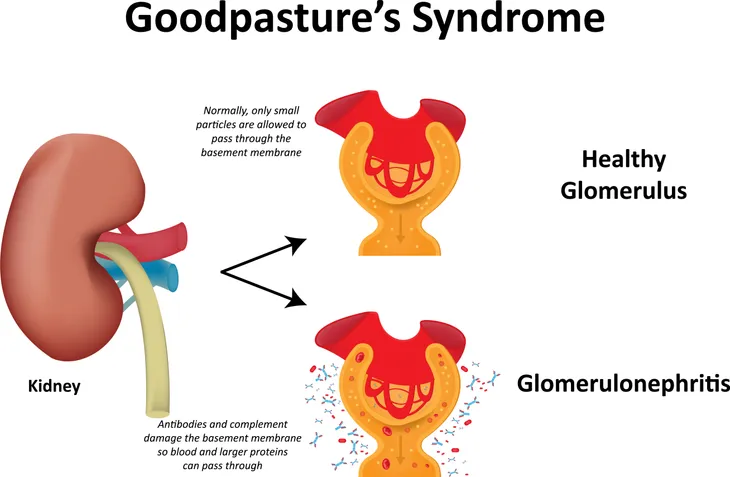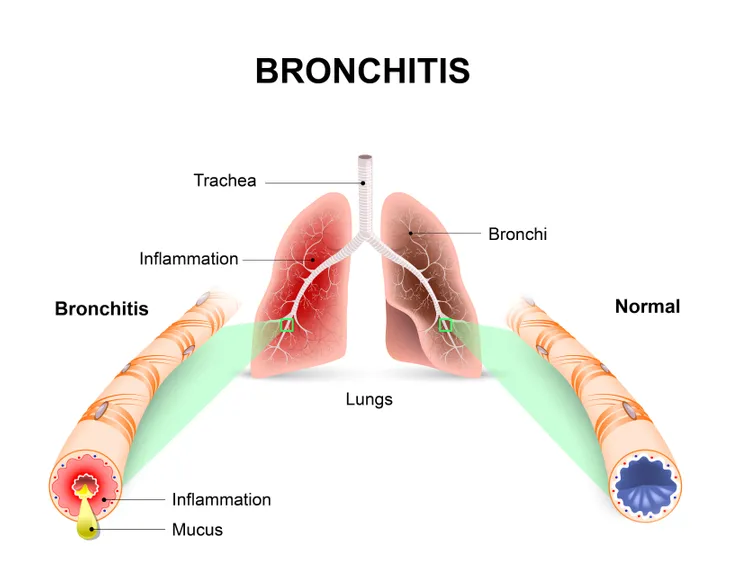Hemoptysis refers to coughing up blood. The source of the blood is typically the respiratory tract and can originate in the nose, mouth, pharynx (throat), bronchial tubes (airways leading to the lungs), or lungs. Hemoptysis can be classified as mild or massive.
Mild hemoptysis is defined as streaking or a small amount of blood intermixed with mucus or pus. The majority of cases of mild hemoptysis are not life threatening. The definition of massive hemoptysis is unclear and ranges from 100-mL to 1,000-mL in a 24-hour period. Massive hemoptysis is a medical emergency and the death rate can be as high as 75-percent. Ten causes of hemoptysis are…
1. Pulmonary Embolus
Pulmonary embolus (PE) refers to a blood clot blocking a pulmonary artery in the lungs. The cause of a PE is usually a blood clot traveling to the lungs from the legs, which is called deep vein thrombosis (DVT). Risk factors such as prolonged immobility, surgery, smoking, obesity, pregnancy, and cancer may increase an individual’s risk of developing both DVT and PE. Rarely does an individual have a single pulmonary embolus.
Symptoms of a PE may include shortness of breath, chest pain, cough, fever, swelling in the calf area, dizziness, and profuse sweating. Treatment of a PE most often involves anticoagulants (blood thinners) or thrombolytics (clot dissolvers). Treatment of a PE should be prompt and it is crucial treatment prevent it from increasing in size and the formation of new clots. A PE can be life threatening and a common complication may be pulmonary hypertension, which is a condition characterized by high blood pressure in the lungs.
2. Tuberculosis
Tuberculosis (TB) is a bacterial infection of the lungs. The disease is contagious and spread through the air via coughs and sneezes. It can spread to any organ in the body through the lymph nodes and bloodstream. Tuberculosis is one of the oldest respiratory diseases known to man. Risk factors increasing the likelihood of developing TB include HIV/AIDS, diabetes, kidney disease, cancer, substance abuse, health care work, and malnutrition.
Tuberculosis can be latent or active. Latent TB causes no symptoms, because the TB bacteria are inactive. It can transform to active TB. Symptoms of active TB may include hemoptysis, chronic cough, chest pain, fever, fatigue, weight loss, and night sweats. Antibiotics are the primary treatment for latent or active TB. Latent TB can be treated successfully with one antibiotic for 9-months. Active TB can be highly resistant to antibiotics so several may be used simultaneously for 1-year or more. Complications of TB may include back pain, joint damage, liver disease, kidney disease, and heart disorders.
3. Pneumonia
Pneumonia is an infection of the lung leading to inflammation of the air sacs, or alveoli. Pneumonia can be caused by a variety of microorganisms, most commonly bacteria, viruses, fungi, or rarely parasites. Streptococcus is the most common bacterial cause of pneumonia. Risk factors increasing the likelihood of developing pneumonia include weakened immune system, smoking, chronic disease (i.e. asthma, heart disease, cancer, diabetes), and being hospitalized.
Symptoms of pneumonia may include hemoptysis, cough, fever, chills, shortness of breath, nausea, vomiting, fatigue, and diarrhea. Pneumonia may be classified as community-associated (occurs outside of healthcare facilities) or healthcare-associated (occurs inside of healthcare facilities). Community-associated is the most common type of pneumonia. Antibiotics are the cornerstone of pneumonia treatment. Complications may include bacteria in the bloodstream, lung abscess, and accumulation of fluid around the lungs.
4. Cystic Fibrosis
Cystic fibrosis (CF) is a congenital (present at birth) genetic disorder of exocrine gland function. Exocrine glands secrete substances by means of ducts. The disease can affect multiple organs, but most commonly (90-percent) affects the lungs. Individuals with CF suffer from chronic respiratory infections. Cystic fibrosis is the most common congenital genetic disorder among Caucasians. Newborn screening for CF is universal in the United States.
Symptoms of CF may include cough, wheezing, shortness of breath, hemoptysis, and chest pain. The primary goal of CF management is the maintenance of lung function by limiting respiratory infections and clearing airways of mucus. An individual born with CF in the United States has a life expectancy of approximately 40-years. End stage lung disease is the primary cause of death in individuals with CF.
5. Pulmonary Arteriovenous Malformation
A pulmonary arteriovenous malformation (PAVM) is an abnormal communication between the pulmonary veins and arteries in the lungs. Most cases are congenital (present at birth). The majority of PAVMs are one-sided and found in the lower lobes of the lungs. They are classified as simple (having only one feeding artery and one draining vein) or complex (having two or more feeding arteries or draining veins). The majority of PAVMs are of the simple type.
Symptoms of PAVMs may include hemoptysis, shortness of breath, chest pain, cough, dizziness, fainting, and double vision. Definitive treatment for PAVMs includes therapeutic embolization or surgical resection. Therapeutic embolization involves occluding the feeding artery or arteries to a PAVM. Surgical techniques used to treat PAVMs include tying off feeding arteries, removal of a lung segment, removal of a lung lobe, or removal of a lung in its entirety. Complications of PAVMs may include seizure, strokes, brain abscess, anemia, and congestive heart failure.
6. Wegener Granulomatosis
Wegener granulomatosis is an autoimmune disorder affecting mainly the respiratory system and kidneys. Autoimmune disorders are characterized by an immune response resulting in the body reacting against its own tissues. No one knows the exact cause of Wegener granulomatosis. The disease is characterized by vasculitis (inflammation of blood vessels) giving way to damage of human organs.
Symptoms of Wegener granulomatosis may include cough, hemoptysis, shortness of breath, chest pain, and granulomas. Granulomas are masses of granulation tissue produced as result of infection or inflammation. The goal of treatment for the condition is to provide long-term remission (disappearance of the disease). Left untreated, Wegener granulomatosis may progress to end stage disease with death from lung or kidney failure within 2-years. Medical treatment may consist of steroids and a medication called cyclophosphamide (Cytoxan). Complications of Wegener granulomatosis may include localized tissue death requiring surgical removal and end stage kidney disease requiring a kidney transplant.
7. Goodpasture Syndrome
Goodpasture syndrome is an autoimmune disorder resulting in damage to the lungs and kidneys. Autoimmune disorders are characterized by an immune response resulting in the body reacting against its own tissues. No one knows the exact cause of Goodpasture syndrome. End stage disease of the disorder is characterized by hemorrhage (bleeding) in the lungs and kidney failure leading to death.
Symptoms of Goodpasture syndrome may include hemoptysis, weight loss, fever/chills, cough, shortness of breath, and chest pain. Other symptoms may include hematuria (blood in the urine), proteinuria (protein in the urine), extremity swelling, uremia (excess levels of the waste urea in the blood), and hypertension (high blood pressure). The cornerstones for the treatment of Goodpasture syndrome are medications for suppression of the immune system, such as steroids and cyclophosphamide, and plasmapharesis, which removes harmful antibodies in the blood. Left untreated, nearly every individual diagnosed with the disorder will die of either chronic kidney failure or lung hemorrhage.
8. Bronchitis
Bronchitis may be defined as inflammation of the bronchial tubes, which lead to the lungs. The condition may be acute (short-lived) or chronic (long-lived). Viruses cause the majority of cases of acute bronchitis, whereas bacteria cause the majority of cases of worsening of chronic bronchitis.
Acute bronchitis is primary cause of acute cough. Other symptoms of acute bronchitis may include hemoptysis, wheezing, shortness of breath, chest pain, low-grade fever, fatigue, and muscle aches. Treatment of acute bronchitis may include inhaled Albuterol via metered dose inhaler or nebulizer (a device that produces a fine spray of liquid which can be inhaled for medicinal purposes). Inhaled steroids may be also be helpful for acute or chronic bronchitis. Worsening chronic bronchitis usually requires management with antibiotics. Anti-cough medications work great to suppress cough, which may worsen at night. The cough of acute bronchitis persists greater than 2-weeks in 25-percent of individuals clinically diagnosed. The cough of acute bronchitis may persist upwards of 8-weeks in some individuals clinically diagnosed.
9. Lung Cancer
Lung cancer is the number one cause of deaths due to cancer in the United States. Individuals who smoke are the greatest risk for developing lung cancer. Other risk factors exposure to passive (or second-hand) smoke, asbestos exposure, a history of exposure to chemotherapy, and chest ionizing radiation exposure. There are two general types of lung cancer—non-small cell and small cell. Non-small lung cancer (NSCLC) includes adenocarcinoma, large cell carcinoma, and squamous cell carcinoma.
Symptoms of lung cancer may include fatigue, loss of appetite, hemoptysis, weight loss, chest pain, shortness of breath, and chronic cough. Treatment for lung cancer may include surgery, chemotherapy, radiation therapy, and targeted drug therapy with agents such as afatinib (Gilotrif) and bevacizumab (Avastin). Complications of lung cancer may include accumulation of fluid in the chest, pain, and metastasis (spread of cancer) to other parts of the body.
10. Congestive Heart Failure
Congestive heart failure (CHF) refers to the heart’s decreased ability to pump blood throughout the body. Increased pressure in the heart eventually causes weakening of its muscle. As a result, blood begins to back up in the cardiovascular system and produce symptoms. The causes of CHF vary and may be attributed to heart disease, heart attack, disease of the heart muscle, hypertension (high blood pressure), and chronic kidney disease.
Symptoms of CHF may include cough, hemoptysis, wheezing, swelling in the extremities, shortness of breath, weight gain, irregular heart rhythms, and fatigue. The goals for management of CHF include decreasing the progression of disease, relief of symptoms, and improving the quality of life in those diagnosed with the disease. Measures that may prevent the progression of CHF include smoking cessation, weight loss, regular exercise, abstinence from alcohol, and control of hypertension (high blood pressure), diabetes, and cholesterol levels. The prognosis of CHF is dictated by factors such as level of heart function, symptoms, and response to an appropriate treatment plan.













